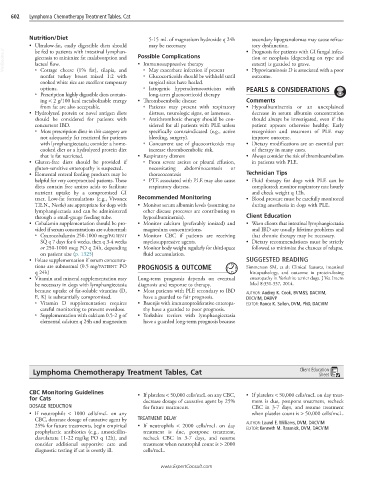Page 1202 - Cote clinical veterinary advisor dogs and cats 4th
P. 1202
602 Lymphoma Chemotherapy Treatment Tables, Cat
Nutrition/Diet 5-15 mL of magnesium hydroxide q 24h secondary lipogranulomas may cause refrac-
tory dysfunction.
• Ultralow-fat, easily digestible diets should may be necessary. • Prognosis for patients with GI fungal infec-
VetBooks.ir giectasia to minimize fat malabsorption and Possible Complications tion or neoplasia (depending on type and
be fed to patients with intestinal lymphan-
extent) is guarded to grave.
lacteal flow.
• Immunosuppressive therapy
○ Cottage cheese (1% fat), tilapia, and
○ Glucocorticoids should be withheld until
nonfat turkey breast mixed 1:2 with ○ May exacerbate infection if present • Hypovitaminosis D is associated with a poor
outcome.
cooked white rice are excellent temporary surgical sites have healed.
options. ○ Iatrogenic hyperadrenocorticism with PEARLS & CONSIDERATIONS
○ Prescription highly digestible diets contain- long-term glucocorticoid therapy
ing < 2 g/100 kcal metabolizable energy • Thromboembolic disease Comments
from fat are also acceptable. ○ Patients may present with respiratory • Hypoalbuminemia or an unexplained
• Hydrolyzed protein or novel antigen diets distress, neurologic signs, or lameness. decrease in serum albumin concentration
should be considered for patients with ○ Antithrombotic therapy should be con- should always be investigated, even if the
concurrent IBD. sidered for all patients with PLE unless patient appears otherwise healthy. Early
○ Most prescription diets in this category are specifically contraindicated (e.g., active recognition and treatment of PLE may
not adequately fat restricted for patients bleeding, surgery). improve outcome.
with lymphangiectasia; consider a home- ○ Concurrent use of glucocorticoids may • Dietary modifications are an essential part
cooked diet or a hydrolyzed protein diet increase thromboembolic risk. of therapy in many cases.
that is fat restricted. • Respiratory distress • Always consider the risk of thromboembolism
• Gluten-free diets should be provided if ○ From severe ascites or pleural effusion, in patients with PLE.
gluten-sensitive enteropathy is suspected. necessitating abdominocentesis or
• Elemental enteral feeding products may be thoracocentesis Technician Tips
helpful for very compromised patients. These ○ PTE associated with PLE may also cause • Fluid therapy for dogs with PLE can be
diets contain free amino acids to facilitate respiratory distress. complicated; monitor respiratory rate hourly
nutrient uptake by a compromised GI and check weight q 12h.
tract. Low-fat formulations (e.g., Vivonex Recommended Monitoring • Blood pressure must be carefully monitored
T.E.N., Nestle) are appropriate for dogs with • Monitor serum albumin levels (assuming no during anesthesia in dogs with PLE.
lymphangiectasia and can be administered other disease processes are contributing to
through a small-gauge feeding tube. hypoalbuminemia). Client Education
• Cobalamin supplementation should be pro- • Monitor calcium (preferably ionized) and • Warn clients that intestinal lymphangiectasia
vided if serum concentrations are subnormal: magnesium concentrations. and IBD are usually lifetime problems and
○ Cyanocobalamin 250-1000 mcg/PATIENT • Monitor CBC if patients are receiving that chronic therapy may be necessary.
SQ q 7 days for 6 weeks, then q 3-4 weeks myelosuppressive agents. • Dietary recommendations must be strictly
or 250-1000 mcg PO q 24h, depending • Monitor body weight regularly for third-space followed to minimize the chances of relapse.
on patient size (p. 1325) fluid accumulation.
• Folate supplementation if serum concentra- SUGGESTED READING
tions are subnormal (0.5 mg/PATIENT PO PROGNOSIS & OUTCOME Simmerson SM, et al: Clinical features, intestinal
q 24h) histopathology, and outcome in protein-losing
• Vitamin and mineral supplementation may Long-term prognosis depends on eventual enteropathy in Yorkshire terrier dogs. J Vet Intern
be necessary in dogs with lymphangiectasia diagnosis and response to therapy. Med 8:331-337, 2014.
because uptake of fat-soluble vitamins (D, • Most patients with PLE secondary to IBD AUTHOR: Audrey K. Cook, BVM&S, DACVIM,
E, K) is substantially compromised. have a guarded to fair prognosis. DECVIM, DABVP
○ Vitamin D supplementation requires • Basenjis with immunoproliferative enteropa- EDITOR: Rance K. Sellon, DVM, PhD, DACVIM
careful monitoring to prevent overdose. thy have a guarded to poor prognosis.
○ Supplementation with calcium 0.5-2 g of • Yorkshire terriers with lymphangiectasia
elemental calcium q 24h and magnesium have a guarded long-term prognosis because
Lymphoma Chemotherapy Treatment Tables, Cat Client Education
Sheet
CBC Monitoring Guidelines • If platelets < 50,000 cells/mcL on any CBC, • If platelets < 50,000 cells/mcL on day treat-
for Cats decrease dosage of causative agent by 25% ment is due, postpone treatment, recheck
DOSAGE REDUCTION for future treatments. CBC in 3-7 days, and resume treatment
• If neutrophils < 1000 cells/mcL on any when platelet count is > 50,000 cells/mcL.
CBC, decrease dosage of causative agent by TREATMENT DELAY
25% for future treatments, begin empirical • If neutrophils < 2000 cells/mcL on day AUTHOR: Laurel E. Williams, DVM, DACVIM
EDITOR: Kenneth M. Rassnick, DVM, DACVIM
prophylactic antibiotics (e.g., amoxicillin- treatment is due, postpone treatment,
clavulanate 11-22 mg/kg PO q 12h), and recheck CBC in 3-7 days, and resume
consider additional supportive care and treatment when neutrophil count is > 2000
diagnostic testing if cat is overtly ill. cells/mcL.
www.ExpertConsult.com

